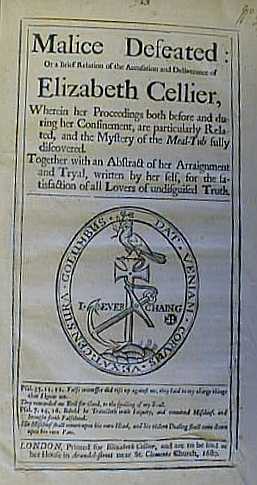Elizabeth Cellier facts for kids
Elizabeth Cellier, known as Mrs. Cellier, was a well-known Catholic midwife in England during the 1600s. She faced serious accusations in 1679 for her supposed role in the 'Meal-Tub Plot'. This plot was said to be against the future King James II. However, she was found innocent and set free.
Later, Cellier was put in prison because of things she wrote in her 1680 book, Malice Defeated. In this book, she shared her side of the story about the alleged plot. She became a pamphleteer, someone who writes and publishes small books or leaflets. She also worked to improve the field of midwifery. In 1687, Cellier published A Scheme for the Foundation of a Royal Hospital. In this plan, she suggested creating a hospital and a school for midwives. She also proposed that London midwives should form a group and use their earnings to set up special houses. These houses would allow any woman to give birth safely. Elizabeth Cellier lived in London, England, until she passed away.
Contents
About Elizabeth Cellier
Elizabeth Cellier was a midwife in London. She became famous mostly because of the "Meal-Tub Plot" in 1680. We do not have many records about her life before she married Peter Cellier, who was French. She also changed her religion from Anglicanism to Catholicism.
A historian named Father John Warner described her as smart and lively. However, he also thought she sometimes made poor decisions. He came to this idea based on how she acted during a time called the Popish Plot.
The Popish Plot and False Accusations
In 1678, many Catholics were put in jail. This happened because of a national scare caused by the "Popish Plot." This plot was made up by a man named Titus Oates. Mrs. Cellier was a kind person. She visited these prisoners to help them. Because she was a midwife, she met many important Catholic ladies. She often helped these ladies send their charity to the prisoners.
One of these kind ladies was the Countess of Powis. She helped a clever trickster named Thomas Dangerfield, who had a long history of criminal behavior. When Lady Powis realized Dangerfield was lying, she stopped helping him. To get back at her, Dangerfield decided to accuse her to the government. He claimed she was involved in a new "Popish Plot."
The Meal-Tub Plot
Dangerfield claimed that Lady Powis and Mrs. Cellier had helped him get out of prison. He said they did this on the condition that he would try to harm the king and other important people. He also claimed he was supposed to help create false plots. These plots would be used to accuse people who did not like the Catholic cause.
One of these made-up plots was supposedly based on a paper hidden in a meal tub at Mrs. Cellier's house. Officials searched her house and found the paper in a meal tub. This paper falsely accused many leading Protestants of serious wrongdoing. These included the king's son, the Duke of Monmouth, and the Earl of Shaftesbury. Even Sir William Waller, who was the official leading the search, was named. Lady Powis and Mrs. Cellier were arrested. Some other Catholics, like the Earl of Castlemaine, were also arrested.
Cellier's Trial and Freedom
Mrs. Cellier's trial happened on June 11, 1680. She was accused of very serious crimes. However, the only person giving evidence against her was Dangerfield himself. It was easy for her to show that he was not a trustworthy witness. The main judge, Sir William Scroggs, had already told juries to ignore what "such a well-known bad person" said.
Cellier was found not guilty. Dangerfield was arrested instead for an old crime he had committed. After Cellier was cleared, she wrote a short book about the whole event. It was called Malice Defeated and was published in 1680. Dangerfield later died in 1685 during a public punishment. He got into a fight with a lawyer, Robert Francis, who was then surprisingly hanged for murder.
Later Accusations and Her Vision
Publishing Malice Defeated led to many other small books being written for and against Cellier. It also led to her second trial. This time, she was accused of making false statements against the king and his government. Cellier had claimed that two witnesses in another case had been tortured. One of these claims, about Miles Prance, was likely true.
According to Roger North, the real reason for this trial was to stop Cellier from speaking up for Catholic nobles who were in prison. For this, she was ordered to pay a large fine of £1,000. She also had to stand three times in the pillory, a device used for public punishment.
During the time of King James II, Cellier suggested a great idea. She proposed creating a group of skilled midwives and a foundling hospital. A foundling hospital was a place for abandoned babies. She thought the money earned by midwives could be used to set up parish houses. These houses would be places where any woman could give birth safely.
It is believed that Elizabeth Cellier is buried in Great Missenden Church, in Buckinghamshire.
In Literature
Mrs. Cellier is an important character in Alison MacLeod's historical novel The Portingale. This book tells the story of Queen Catherine of Braganza.


